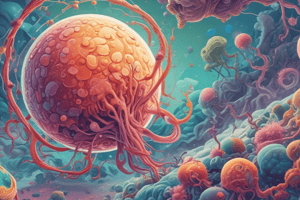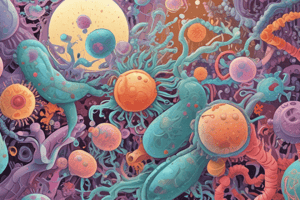Podcast
Questions and Answers
¿Cuál es una característica de la bacteria Pseudomonas aeruginosa?
¿Cuál es una característica de la bacteria Pseudomonas aeruginosa?
- Es un patógeno oportunista que solo afecta a individuos sanos
- Produce un pigmento azul-verde llamado pioycianina (correct)
- Es un bacilo gram-positivo
- Es una bacteria anaeróbica
¿Cuál es la función de las enzimas producidas por Stenotrophomonas maltophilia en su patogenia?
¿Cuál es la función de las enzimas producidas por Stenotrophomonas maltophilia en su patogenia?
- Dependen de la resposta inmune del huésped
- Contribuyen a la resistencia a antibióticos
- Inhiben el crecimiento de otras bacterias
- Descomponen proteínas, lípidos y ácidos nucleicos (correct)
¿Cuál es una característica de la resistencia a antibióticos de Acinetobacter baumannii?
¿Cuál es una característica de la resistencia a antibióticos de Acinetobacter baumannii?
- Falta de producción de biomembranas
- Sensibilidad a aminoglucósidos
- Producción de beta-lactamasas (correct)
- Activación de sistemas de transporte de antibióticos
¿Cuál es un tipo de infección comúnmente asociada con bacterias no fermentativas gram-negativas?
¿Cuál es un tipo de infección comúnmente asociada con bacterias no fermentativas gram-negativas?
¿Cuál es un resultado común en pacientes con infecciones por Acinetobacter baumannii?
¿Cuál es un resultado común en pacientes con infecciones por Acinetobacter baumannii?
¿Cuál es la característica distintiva de los bacilos gramnegativos no fermentativos?
¿Cuál es la característica distintiva de los bacilos gramnegativos no fermentativos?
¿Qué tipo de infecciones se asocian comúnmente con los bacilos gramnegativos no fermentativos?
¿Qué tipo de infecciones se asocian comúnmente con los bacilos gramnegativos no fermentativos?
¿Qué bacteria se asocia comúnmente con infecciones crónicas en individuos con fibrosis quística?
¿Qué bacteria se asocia comúnmente con infecciones crónicas en individuos con fibrosis quística?
¿Qué característica de Acinetobacter baumannii hace que sea un patógeno desafiante de tratar?
¿Qué característica de Acinetobacter baumannii hace que sea un patógeno desafiante de tratar?
¿Qué dispositivo médico se asocia comúnmente con infecciones nosocomiales causadas por bacilos gramnegativos no fermentativos?
¿Qué dispositivo médico se asocia comúnmente con infecciones nosocomiales causadas por bacilos gramnegativos no fermentativos?
Flashcards are hidden until you start studying
Study Notes
Non-Fermentative Bacilli
Pseudomonas aeruginosa Characteristics
- Gram-negative, aerobic, rod-shaped bacterium
- Found in soil, water, and human gut
- Opportunistic pathogen, causing infections in immunocompromised individuals
- Produces blue-green pigment pyocyanin, which has antimicrobial properties
- Can form biofilms, making it resistant to antibiotics and host immune system
Stenotrophomonas maltophilia Pathogenesis
- Opportunistic pathogen, often affecting immunocompromised individuals
- Causes a range of infections, including pneumonia, bacteremia, and urinary tract infections
- Produces a variety of enzymes, including proteases, lipases, and DNases, which contribute to its pathogenesis
- Can form biofilms, making it resistant to antibiotics and host immune system
Acinetobacter baumannii Drug Resistance
- Multidrug-resistant, with high levels of resistance to antibiotics, including carbapenems and aminoglycosides
- Resistance mechanisms include:
- Production of beta-lactamases, which break down antibiotics
- Alterations in porin proteins, reducing antibiotic uptake
- Activation of efflux pumps, which remove antibiotics from the cell
- High mortality rates associated with A. baumannii infections, particularly in intensive care units
Non-Fermentative Gram-Negative Bacilli
- Group of bacteria that do not ferment glucose, including Pseudomonas, Stenotrophomonas, and Acinetobacter
- Characterized by their ability to oxidize glucose, rather than fermenting it
- Often associated with nosocomial infections, particularly in immunocompromised individuals
Hospital-Acquired Infections
- Non-fermentative bacilli are common causes of hospital-acquired infections, including:
- Pneumonia
- Urinary tract infections
- Bacteremia
- Wound infections
- Often associated with the use of medical devices, such as ventilators and catheters
- Can be difficult to treat due to high levels of antibiotic resistance
Burkholderia cepacia
- Gram-negative, aerobic bacterium
- Found in soil and water, and can colonize human respiratory tract
- Can cause chronic infections, particularly in individuals with cystic fibrosis
- Produces a variety of enzymes, including proteases and lipases, which contribute to its pathogenesis
- Can be resistant to multiple antibiotics, making treatment challenging
Studying That Suits You
Use AI to generate personalized quizzes and flashcards to suit your learning preferences.




